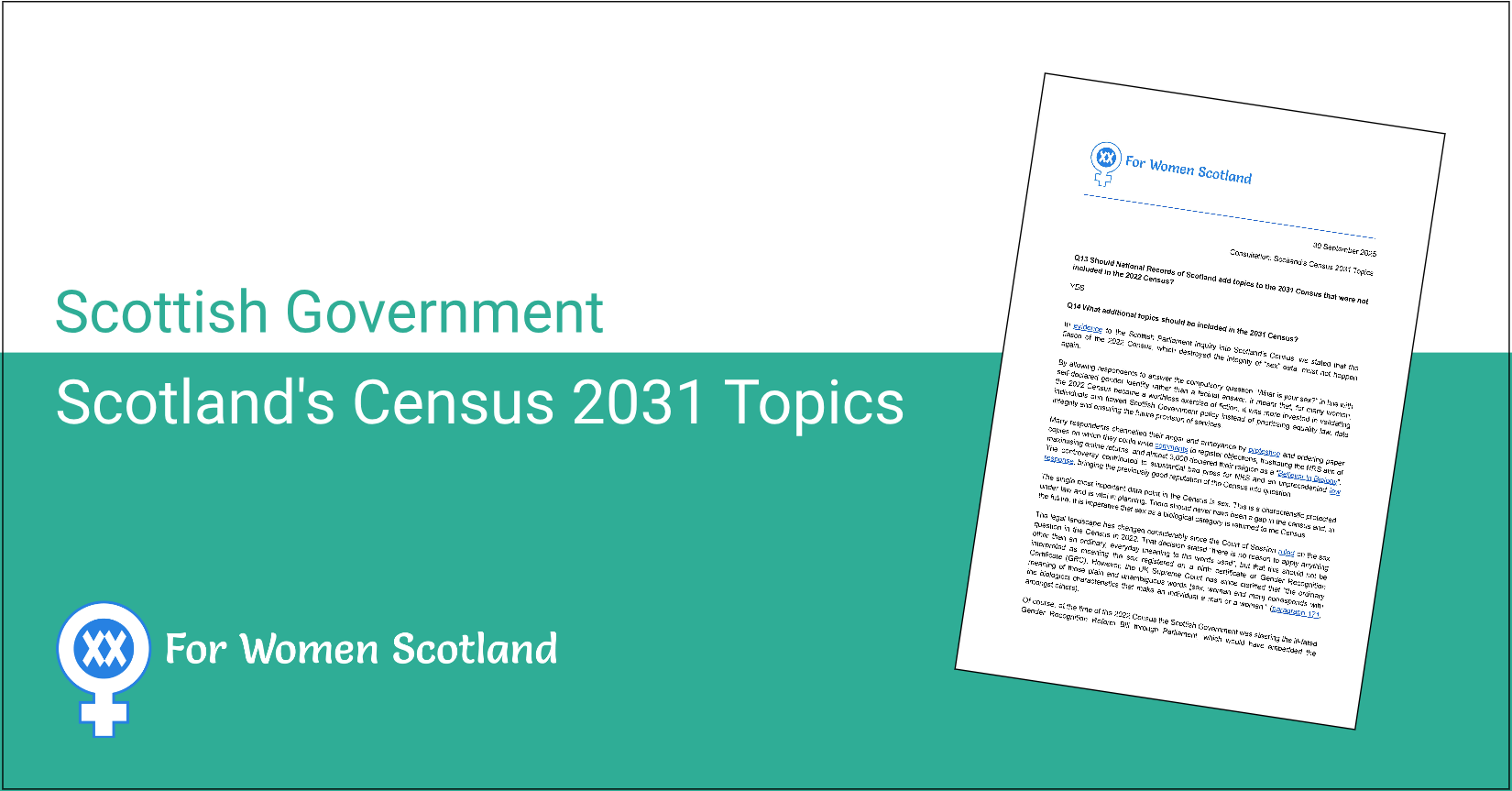Scotland’s Census 2031

This is our submission to the Scottish Government’s consultation on the future requirements of the census and the topics to be included in 2031. The consultation has been extended and now closes on 11 November 2025.
Q13. Should National Records of Scotland add topics to the 2031 Census that were not included in the 2022 Census?
Yes
Q14. What additional topics should be included in the 2031 Census?
In evidence to the Scottish Parliament Inquiry into Scotland’s Census, we stated that the fiasco of the 2022 Census, which destroyed the integrity of “sex” data, must not happen again.
By allowing respondents to answer the compulsory question “What is your sex?” in line with self-declared gender identity rather than a factual answer, it meant that, for many women, the 2022 Census became a worthless exercise of fiction. It was more invested in validating individuals and flawed Scottish Government policy instead of prioritising equality law, data integrity and ensuring the future provision of services.
Many respondents channelled their anger and annoyance by protesting and ordering paper copies on which they could write comments to register objections, frustrating the NRS aim of maximising online returns, and almost 3,000 declared their religion as a “Believer in Biology”. The controversy contributed to substantial bad press for NRS and an unprecedented low response, bringing the previously good reputation of the Census into question.
The single most important data point in the Census is sex. This is a characteristic protected under law and is vital in planning. There should never have been a gap in the census and, in the future, it is imperative that sex as a biological category is returned to the Census.
The legal landscape has changed considerably since the Court of Session ruled on the sex question in the Census in 2022. That decision stated “there is no reason to apply anything other than an ordinary, everyday meaning to the words used”, but that this should not be interpreted as meaning the sex registered on a birth certificate or Gender Recognition Certificate (GRC). However, the UK Supreme Court has since clarified that “the ordinary meaning of those plain and unambiguous words [sex, woman and man] corresponds with the biological characteristics that make an individual a man or a woman.” (paragraph 171, amongst others).
Of course, at the time of the 2022 Census the Scottish Government was steering the ill-fated Gender Recognition Reform Bill through Parliament, which would have embedded the concept of self-identification of sex had it not been halted by the Section 35 Order from the UK Government. The supposed alignment of the Census with that proposed law was inappropriate and dangerously pre-emptive. By the time the Supreme Court considered the matter in 2025 the only possible meaning of “sex” was either biological or certificated (to include GRCs). Self-identification of sex as a concept has categorically been ruled out by the apex court.
The Sullivan Review of data, statistics and research on sex and gender recommended that data collection on sex, including for the purpose of fulfilling the Public Sector Equality Duty (PSED), should refer to biological rather than certificated sex. Although this was published before the Supreme Court judgment in April, the ruling only cemented the review’s conclusions and removed any possible uncertainty.
The judgment explicitly set out the implications for data collection and the reasoning regarding the irrationality which would be entailed by collecting data on certificated sex. It is worth noting the following excerpts:
238. As we have explained, all organisations subject to the PSED must have due regard, in considering their rules, policies or practices, to the matters set out in section 149, undertaking where appropriate an equality impact assessment in order to understand how and to what extent the policy in question will affect specific groups with different protected characteristics. Organisations and bodies that are subject to the PSED are required to collect data in order to fulfil this duty.
239. If, in the context of equality between the sexes, the interests of trans women (biological males) who have GRCs (so are legally female) must be considered and advanced as part of the group that share the protected characteristic of being “women”, the PSED will require data collection and consideration of a heterogenous group containing biological women, some biological males with a GRC (trans women who are legally female) and excluding some biological females with a GRC (trans men who are legally male). This is a confusing group to envisage because it cuts across and fragments both biological sex and gender reassignment into heterogenous groupings which may have little in common. Any data collection exercise will be distorted by the heterogenous nature of such a group. Moreover, the distinct discrimination and disadvantage faced by women as a group (or trans people) would simply not be capable of being addressed by the PSED because the group being considered would not be a group that, because of the shared protected characteristic of sex, has experienced discrimination or disadvantage flowing from shared biology, societal norms or prejudice. Whereas the interests of biological women (or men) can be rationally considered and addressed, and likewise, the interests of trans people (who are vulnerable and often disadvantaged for different reasons), we do not understand how the interests of this heterogenous group can begin to be considered and addressed.
The judgment refers to the fact that categories which cut across each other are unhelpful and lead to absurdities. It brings complete clarity for organisations collecting data on sex to fulfill their PSED under the Equality Act 2010. All public bodies, including NRS now have a duty to collect data on sex on a biological basis and we trust that, as the gold standard, the Census will return to form and lead the way with data that is both robust and trustworthy, and collected in compliance with the law.
